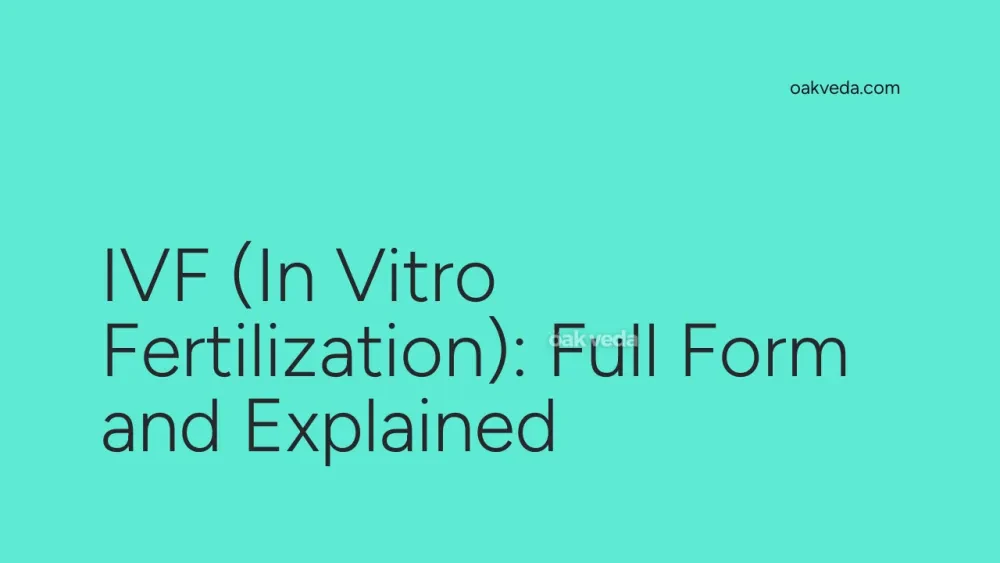
What is the Full Form of IVF?
The full form of IVF is In Vitro Fertilization. This advanced reproductive technology has revolutionized fertility treatment, offering hope to millions of couples struggling to conceive naturally.
What is In Vitro Fertilization?
In Vitro Fertilization, commonly known as IVF, is a complex series of procedures used to help with fertility or prevent genetic problems and assist with the conception of a child. During IVF, mature eggs are collected from ovaries and fertilized by sperm in a lab. Then the fertilized egg (embryo) or eggs (embryos) are transferred to a uterus.
Origin and Development of In Vitro Fertilization
The concept of IVF dates back to the 1870s when the first documented artificial insemination in rabbits was performed. However, it wasn't until 1978 that the first successful human IVF procedure resulted in the birth of Louise Brown, often referred to as the world's first "test-tube baby." Since then, IVF technology has advanced significantly, becoming more efficient and accessible.
How does In Vitro Fertilization work?
The IVF process involves several key steps:
- Ovarian Stimulation: Fertility medications are used to stimulate the ovaries to produce multiple eggs.
- Egg Retrieval: A minor surgical procedure is performed to extract eggs from the ovaries.
- Sperm Retrieval: A sperm sample is collected from the male partner or a donor.
- Fertilization: Eggs and sperm are combined in a laboratory dish to facilitate fertilization.
- Embryo Culture: Fertilized eggs are monitored for several days as they develop into embryos.
- Embryo Transfer: One or more embryos are transferred into the uterus.
Types of In Vitro Fertilization
While the basic IVF procedure remains the same, there are several variations:
- Conventional IVF: The standard procedure as described above.
- ICSI (Intracytoplasmic Sperm Injection): A single sperm is injected directly into an egg.
- Mini-IVF: Uses lower doses of fertility medications.
- Natural Cycle IVF: Relies on the natural menstrual cycle without fertility drugs.
Functions of In Vitro Fertilization
The primary functions of IVF include:
- Overcoming infertility caused by blocked or damaged fallopian tubes
- Addressing male factor infertility
- Assisting with age-related fertility decline
- Enabling genetic screening to prevent hereditary diseases
Applications of In Vitro Fertilization
IVF has a wide range of applications in reproductive medicine:
- Treating unexplained infertility
- Addressing ovulation disorders
- Preserving fertility for cancer patients
- Enabling same-sex couples to have biological children
- Facilitating surrogacy arrangements
Features of In Vitro Fertilization
Key features of IVF include:
- Customization: Treatment can be tailored to individual patient needs.
- Genetic Screening: Embryos can be tested for genetic abnormalities before transfer.
- Cryopreservation: Unused embryos can be frozen for future use.
- High Success Rates: IVF has significantly higher success rates compared to other fertility treatments.
Benefits of In Vitro Fertilization
IVF offers numerous benefits:
- Increased Chances of Conception: Especially for couples with complex fertility issues.
- Genetic Control: Ability to screen for genetic disorders.
- Timing Control: Allows for planned pregnancies.
- Multiple Pregnancy Option: Possibility of having twins or triplets (though this is generally not recommended due to associated risks).
Limitations or Challenges of In Vitro Fertilization
Despite its success, IVF does have some limitations:
- Cost: The procedure can be expensive and is not always covered by insurance.
- Physical and Emotional Stress: The process can be demanding on the body and mind.
- Multiple Pregnancy Risks: Increased chance of multiple births, which carry higher risks.
- Potential Side Effects: From hormonal treatments and egg retrieval procedures.
Future Developments in In Vitro Fertilization Technology
The field of IVF continues to evolve:
- Artificial Intelligence: AI is being used to improve embryo selection.
- In Vitro Gametogenesis: Research into creating eggs and sperm from other body cells.
- Uterus Transplants: Expanding options for those without a functioning uterus.
- Improved Genetic Screening: More comprehensive and accurate genetic testing of embryos.
FAQs on IVF Full Form
-
What does IVF stand for in medical terms? IVF stands for In Vitro Fertilization.
-
How long does an IVF cycle typically take? An IVF cycle usually takes about two to three weeks.
-
What is the success rate of IVF? Success rates vary but generally range from 20% to 35% per cycle, depending on various factors including age.
-
Is IVF painful? While some discomfort may be experienced during egg retrieval, most patients report minimal pain throughout the process.
-
How many embryos are typically transferred during IVF? The number of embryos transferred depends on various factors, but generally, one or two embryos are transferred to reduce the risk of multiple pregnancies.
In conclusion, In Vitro Fertilization (IVF) has transformed the landscape of reproductive medicine, offering hope to many who struggle with infertility. As technology advances, IVF continues to become more effective and accessible, helping countless individuals and couples achieve their dreams of parenthood.
You may be interested in:
- IIFL (India Infoline Limited): Full Form and Overview
- UV (Ultraviolet): Full Form, Types, and Applications
- RAW (Research and Analysis Wing): India's Intelligence Agency
- INR (Indian Rupee): Full Form and Comprehensive Guide
- IMF (International Monetary Fund): Full Form Explained
- MS (Full Form): Master of Surgery, Science, and Microsoft

